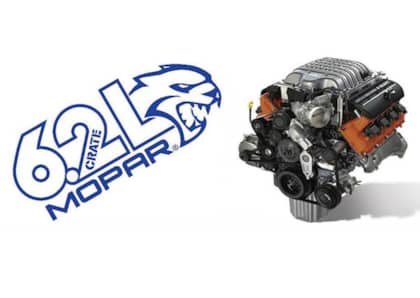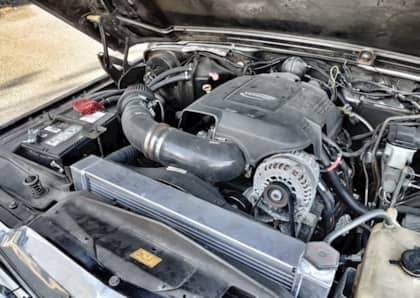Power Play: Mercury’s New Crate Engine Puts the Rest to Shame
What a time to be alive. Production cars that do wheelies are sold alongside hydrogen-powered ones that only emit water. The fact is, the auto industry is listening to what the consumers want, but they’re not the only ones with open ears. Mercury Marine, which is best known for manufacturing inboard and outboard marine engines, has its own performance division called Mercury Racing. They just turned up the heat on one of the best-performing automotive crate engine platforms in the world—the GM LS7.

LS7-Modded Insanity
Introducing the Mercury Racing SB4 crate engine. 7.0L and 428 cubic inches of small-block displacement, naturally aspirated to make a staggering 750hp at a screaming 8000 rpm—on pump gas alone. That’s right, read it again. It’s hard to imagine how Mercury was able to pack so much face-melting power into a small-block, but the design is rather ingenious. Using the GM LS7 block, Mercury designed a set of aluminum DOHC (dual overhead cam) cylinder heads, providing four valves per cylinder. By ditching the pushrods and adding two valves to each cylinder, the engineers at Mercury were able to move more air, faster through the LS7 block, resulting in an increase of 245hp over the LS7’s advertised 505hp. Not only did the new DOHC heads increase the power output of the LS7 block, but they also opened up an extra 1000 rpm in the top end.
Mercury is selling this crate engine as a turn-key product, including a fully tuned ECU and wiring harness. It even comes with the front end drive components such as the alternator, AC pump, pulleys, belts and all necessary brackets. There’s also an option to upgrade to a carbon fiber intake manifold cover and have it painted any color you want.

The Size Difference
Now I know what you’re thinking. What’s the catch? Well, if we’re going to be honest, there’s actually several. The allure of the LS platforms has long been their compact size, able to fit into almost any car or truck’s engine bay (sometimes with the help of a Sawzall). DOHC V8 engines are known for being extremely wide and cumbersome to swap when compared to the LS motor (see Coyote swaps). While the Mercury SB4 is 3 inches longer and 2 inches wider than the LS7, it’s about the same height as its GM counterpart. Good news for many who don’t want to buy a taller hood.
Will It Be Reliable?
Beyond physical dimensions, another aspect to consider is reliability and availability of parts. The LS platform is known for being reliable (when built correctly), and easily tuned. Anyone with half a gearhead brain can figure out how to put it in almost anything. Furthermore, not much has changed with the LS platform since the late ‘90s. With nearly endless ways to build one, many parts of the LS engines are interchangeable, and the aftermarket support is still thriving. GM’s LS7 crate engine, although bare-bones, comes with an invaluable sense of confidence for the buyer. The Mercury SB4 debuted at last year’s SEMA Show, and has only been on the market for a few months since then. Although Mercury stands behind their product, offering a limited 12-month warranty with each purchase, only time will tell how reliable this new crate engine really is.

Price
Of course, we can’t forget to talk about the price. After all, if you’re in the market for a crate engine, chances are you’ll have a budget in mind. In this case, a little comparison puts things into perspective. GM has recently dropped the MSRP on their 505hp 7.0L LS7 crate engine to $14,837, not including the ECU or wiring harness required to run the engine. Ford Performance offers their 435hp 5.0L Coyote crate engine for $7,975 MSRP, again minus the ECU and wiring harness. Mercury Racing prices their SB4 at a cool $32,995, but it does come with the computer and wiring to run it. Worth it? That just depends on how crazy your build will get. A fully dressed LS7 from a performance engine builder can easily surpass $33,000, and good luck getting a warranty on it. Currently, the Mercury Racing SB4 is only available to purchase from one of the most prominent hot rod builders in the nation, the Roadster Shop, in Mundelein, Illinois—a fitting retailer for such a performance-driven piece of engineering.

So there you have it. Is Mercury Racing on the cutting edge of a new trend, one where manufacturers bleed into other industries and improve upon decades-old designs to meet the needs of tomorrow’s consumer? Or is this simply an isolated incident where somebody paid attention and did something the right way to show that it can be done? Is Mercury Racing ahead of its time with the SB4? The answer lies in the future and how the auto industry continues to grow in oddly polarizing tangents, from fully electric powered commuters to the most powerful fossil fuel burners our world has ever seen.

Full Spec List:
- Power: 750HP/559 LB-FT @ 8000 RPM
- Cylinders/Engine Configuration: V-8, 32-Valve Double Overhead Cam (DOHC)
- Valve Actuation: Shaft Mounted, End Pivot Finger Follower With Mechanical Lash Adjustment
- Displacement (CID/L): 428/7.0
- Bore (IN/MM): 4.125/104.775
- Stroke (IN/MM): 4.0/101.60
- Compression Ratio: 11.7:1
- Induction System: Naturally Aspirated with Twin Electronic Throttle Bodies
- Fuel Sysrtem: Sequential Port Fuel Injected (SPFI)
- Fuel Requirements: Unleaded 91 Octane (R + M/2)
- Ignition System: Individual Coil on Plug, With Integrated Drivers
- Charging System: 105 Amp (1481 Watt) Alternator
- Controller: Mercury Racing PCM
- Cooling System: Water Cooled With 160-degree thermostat
- Lubrication System: Wet Sump With Modified Holley 302-1 Pan, GM High Volume Oil Pump
- Oil Requirement: Premium Synthetic 15W-50 for warm weather use
- Oil Capacity With Filter (Quarts): 6.5
- Transmission: Engine is Capable of Operating with Customer Supplied Manual or Automatic Transmission
- Length (IN/MM): 27.1/688
- Width (Across Timing Cover) (IN/MM): 30.27/769
- Width (Across Rear of Heads) (IN/MM): 29.1/740
- Height (IN/MM): 17.1/435
- Weight (LBS/KG): 560/254
- Warranty: 12-Month Limited
Photos courtesy of the Roadster Shop and Mercury Racing
More From Driving Line
- Ready to swap? Read this article before touching a single bolt!











